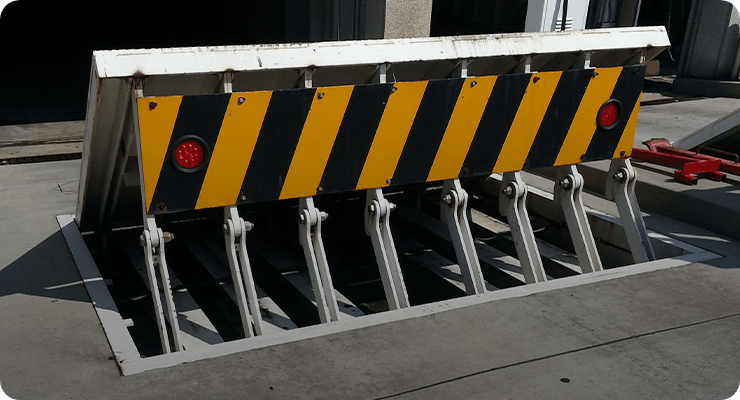The Only Guide to Wedge Barriers
Table of ContentsWedge Barriers Can Be Fun For AnyoneWhat Does Wedge Barriers Mean?


18 may be done much more promptly, conveniently, and price effectively. FIG. In particular embodiments, the anchor 30 may be a steel structure including plates, beam of lights(e. g., I-beams ), and/or other frameworks that are safeguarded within the structure 14, which might be concrete. At the surface 12, an upper side 28 of the support 30 might be at least partially subjected
, therefore allowing the accessory of the barrier 10 to the anchor 30. g., threaded holes)in one or more beams or plates of the anchor 30 may be revealed to the surface area 12. In this fashion, bolts 32 or various other mechanical fasteners might be used to secure the obstacle 10 to the anchor 30. As the barrier 10 is installed to the surface 12 of the structure 14, collection of particles and other product beneath the barrier might be lowered, and components of the bather 10 might not be subjected to listed below grade environments. As indicated by recommendation numeral 52, the lifting device 50 consists of elements disposed beneath the wedge plate 16. The components 52 under the wedge plate 16 might consist of an electromechanical actuator, a camera, one or even more cam surfaces, and so forth. In addition, the lifting system 50 consists of a spring setting up 54
The spring pole 58 is combined to a webcam(e. g., camera 80 received FIG. Resources 4) of the lifting system 50. The springs 60 disposed regarding the springtime pole 58 are held in compression by springtime supports 62, including a taken care of springtime support 64. That is, the set spring assistance 64 is taken care of about the foundation 14 and the rest of the bather 10.
Wedge Barriers Fundamentals Explained
The staying force applied to
the cam to deploy release wedge plate 16 may might provided offered an electromechanical actuator 84 or other various other. The springtime assembly 54 and the actuator 84(e. Wedge Barriers. g., electromechanical actuator)may operate with each other to translate the cam and raise the wedge plate 16.
As stated over, the springtime setting up 54 applies a constant pressure on the web cam, while the electromechanical actuator may be regulated to exert a variable pressure on the webcam, thereby making it possible for the training and decreasing( i. e., releasing and retracting )of the wedge plate 16. In specific embodiments, the continuous pressure used by the springtime setting up 54 may be adjustable. g., electromechanical actuator) is handicapped. As will certainly be valued, the springtime assembly 54 may be covered and shielded from debris or various other components by a cover plate(e. g., cover plate 68 revealed in FIG. 4) that may be substantially flush with the raised surface area 38 of the structure 14. As pointed out over, in the deployed setting, the wedge plate 16 offers to obstruct gain access to or travel beyond the barrier 10. As an example, the obstacle 10(e. g., the wedge plate 16 )might obstruct pedestrians or lorries from accessing a home or path. As gone over over, the barrier 10 is affixed to the support 30 protected within the foundation 14,

front brackets 71. Therefore, the linkage assemblies 72 may pivot and rotate to enable the collapse and extension of the linkage settings up 72 throughout retraction and implementation of the bather 10. The link assemblies 72 reason movement of the wedge plate 16 to be limited. If a car is traveling towards the released wedge plate 16(e. For instance, in one situation, the safety and security legs 86 might be prolonged duringmaintenance of the barrier 10. When the safety legs 86 are deployed, the safety legs 86 support the weight of the wedge plate 16 against the surface 12. Consequently, the training system 50 may be deactivated, serviced, gotten rid of, changed, etc. FIG. 5 is partial perspective view of an embodiment of the surface-mounted wedge-style barrier 10, highlighting the webcam 80 and the cam surface areas 82 of the lifting mechanism 50. Specifically, two cam surfaces 82, which are described as lower cam surface areas 83, are placed below the web cam 80. The lower camera surfaces 83 internet might be taken care of to the surface 12 (e. As an example, the reduced webcam surfaces 83 and the placing you can try this out plate 85 might create a solitary item that is protected to the anchor 30 by screws or other mechanical bolts. In addition, 2 camera surface areas 82, which are described as top camera surface areas 87, are placed over the camera 80 and combined to (e. In various other personifications, interfering layers or plates might be placed in between the surface area 12 and the reduced web cam surface areas 83 and/or the wedge plate 16 and the top web cam surface areas 87 As mentioned above, the cam
80 translates along the webcam surface areas 82 when the wedge plate 16 is lifted from the pulled back setting to the released position. Additionally, as discussed over, the spring setting up 54 (see FIG. 3 )may supply a pressure acting on the cam 80 in the direction 102 by means of springtime pole 58, which may decrease the force the electromechanical actuator 84 is required to use to the webcam 80 in order to activate and lift the wedge plate 16. 1 )to the deployed placement(see FIG. 4). As shown, the web cam 80 consists of track wheels 104(e. g., rollers), which get in touch with and translate along the webcam surfaces 82 during operation.